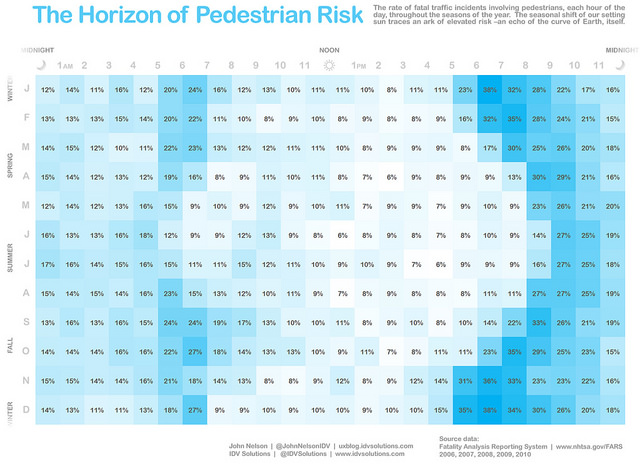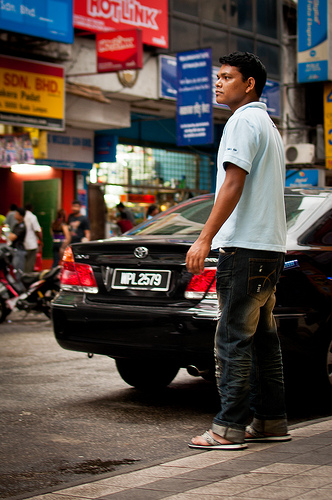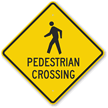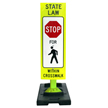The most dangerous time to cross the street
It sounds like the opening of a bad joke: When is the worst time to cross the street? The answer has serious implications for pedestrian safety. As reported by FastCompany, five years of National Highway Traffic Safety Administration (NHTSA) data reveals that twilight is the most dangerous time for pedestrians to cross the street.
User experience designer John Nelson created this illustrative chart, “The Horizon of Pedestrian Risk,” revealing “the rate of fatal traffic accidents involving pedestrians, each hour of the day, throughout the seasons of the year.” (Researchers had designed a similar chart in 2010, corresponding to this study.)

A heatmap showing when most pedestrian accidents happen. From IDVsolutions.
That twilight is the most dangerous period may come as a surprise. Wouldn’t the wee hours of the night — cars driven recklessly by weary or possibly drunk drivers; pedestrians obscured by the darkness — qualify as the most fatal? There is no clear-cut answer, but researchers venture a few. For one, it’s possible that pedestrians exert more care late at night.
Eyesight plays a role, too. “When you’re in a car, you’re in an enclosed box, and as it’s harder to tell as it’s getting slightly darker,” Julia Griswold, a postdoctoral researcher at University of California-Berkeley, told FastCompany. (Griswold is one of the authors of the 2010 study.) “But pedestrians out on the street are less aware of their reduced visibility, so they might not be as careful as they should be.”
The chart’s data is aggregated, spanning the entire nation. So, while specifics vary, some solutions can be targeted to time of day. Researchers recommend a few options: “It could be a matter of speed limit enforcement at that time of day, say in the winter at rush hour, since that’s a particularly heavy time,” Griswold said. Pedestrian and driver education ought to include warnings about twilight safety. And the researchers also recommend considering extending daylight savings time for improved visibility for driving commuters.

From Mark Fischer.
More specific solutions tailored to individual locales may include adding or improving crosswalks and sidewalks; improving lighting, and considering weather conditions. As FastCompany points out, even supremely walkable cities, such as New York City, are not pedestrian-safe: 156 people in New York were hit by cars while crossing streets or on sidewalks.
Though dusk is the worst time, it is true that more pedestrians are hit and killed during the night than during the day. “The seasonal shift of our setting sun traces an ark [sic] of elevated risk – an echo of the curve of the Earth, itself,” reads the chart. Accidents are more likely to occur at certain times of the year — such as during the wintertime evening commute — and on particular days — such as Friday and Saturday nights in the summer.
The chart inadvertently, yet fittingly, reveals a rounded image that calls to mind the globe itself: Sums up chartmaker Nelson, “Twilight is relative depending on the season, so you see the arc of sunset pushing out through summer months and back in for the winter months. All because we live on a round thing flying through space. The nature of that roundness is unintentionally revealed in this data.”
Category: Pedestrian safety, Resources


















